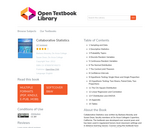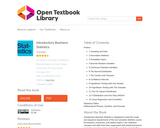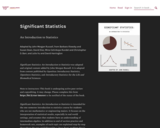Introductory Statistics was conceived and written to fit a particular topical sequence, but it can be used flexibly to accommodate other course structures. One such potential structure, which fits reasonably well with the textbook content, is provided below. Please consider, however, that the chapters were not written to be completely independent, and that the proposed alternate sequence should be carefully considered for student preparation and textual consistency.
1: Sampling and Data
Included in this chapter are the basic ideas and words of probability and statistics. You will soon understand that statistics and probability work together. You will also learn how data are gathered and what "good" data can be distinguished from "bad."
1.1: Introduction
1.2: Definitions of Statistics, Probability, and Key Terms
1.3: Data, Sampling, and Variation in Data and Sampling
1.4: Frequency, Frequency Tables, and Levels of Measurement
1.5: Experimental Design and Ethics
1.6: Data Collection Experiment (Worksheet)
1.7: Sampling Experiment (Worksheet)
1.E: Sampling and Data (Exercises)
2: Descriptive Statistics
In this chapter, you will study numerical and graphical ways to describe and display your data. This area of statistics is called "Descriptive Statistics." You will learn how to calculate, and even more importantly, how to interpret these measurements and graphs.
2.1: Prelude to Descriptive Statistics
2.2: Stem-and-Leaf Graphs (Stemplots), Line Graphs, and Bar Graphs
2.3: Histograms, Frequency Polygons, and Time Series Graphs
2.4: Measures of the Location of the Data
2.4E: Measures of the Location of the Data (Exercises)
2.5: Box Plots
2.6: Measures of the Center of the Data
2.7: Skewness and the Mean, Median, and Mode
2.8: Measures of the Spread of the Data
2.9: Descriptive Statistics (Worksheet)
2.E: Descriptive Statistics (Exercises)
3: Probability Topics
Probability theory is concerned with probability, the analysis of random phenomena. The central objects of probability theory are random variables, stochastic processes, and events: mathematical abstractions of non-deterministic events or measured quantities that may either be single occurrences or evolve over time in an apparently random fashion.
3.1: Introduction
3.2: Terminology
3.3: Independent and Mutually Exclusive Events
3.4: Two Basic Rules of Probability
3.5: Contingency Tables
3.6: Tree and Venn Diagrams
3.7: Probability Topics (Worksheet)
3.E: Probability Topics (Exercises)
4: Discrete Random Variables
4.1: Prelude to Discrete Random Variables
4.2: Probability Distribution Function (PDF) for a Discrete Random Variable
4.3: Mean or Expected Value and Standard Deviation
4.4: Binomial Distribution
4.5: Discrete Distribution (Playing Card Experiment)
4.6: Discrete Distribution (Lucky Dice Experiment)
4.E: Discrete Random Variables (Exercises)
5: Continuous Random Variables
5.1: Introduction
5.2: Continuous Probability Functions
5.3: The Uniform Distribution
5.4: Continuous Distribution (Worksheet)
5.E: Continuous Random Variables (Exercises)
5.E: Exercises
6: The Normal Distribution
In this chapter, you will study the normal distribution, the standard normal distribution, and applications associated with them. The normal distribution has two parameters (two numerical descriptive measures), the mean ( μμ ) and the standard deviation ( σσ ).
6.1: Prelude to The Normal Distribution
6.2: The Standard Normal Distribution
6.1E: The Standard Normal Distribution (Exercises)
6.3: Using the Normal Distribution
6.4: Normal Distribution - Lap Times (Worksheet)
6.5: Normal Distribution - Pinkie Length (Worksheet)
6.E: The Normal Distribution (Exercises)
7: The Central Limit Theorem
In a population whose distribution may be known or unknown, if the size (n) of samples is sufficiently large, the distribution of the sample means will be approximately normal. The mean of the sample means will equal the population mean. The standard deviation of the distribution of the sample means, called the standard error of the mean, is equal to the population standard deviation divided by the square root of the sample size (n).
7.1: Prelude to the Central Limit Theorem
7.2: The Central Limit Theorem for Sample Means (Averages)
7.2E: The Central Limit Theorem for Sample Means (Exercises)
7.3: The Central Limit Theorem for Sums
7.4: Using the Central Limit Theorem
7.4E: Using the Central Limit Theorem (Exercises)
7.5: Central Limit Theorem - Pocket Change (Worksheet)
7.6: Central Limit Theorem - Cookie Recipes (Worksheet)
7.E: The Central Limit Theorem (Exercises)
8: Confidence Intervals
In this chapter, you will learn to construct and interpret confidence intervals. You will also learn a new distribution, the Student's-t, and how it is used with these intervals. Throughout the chapter, it is important to keep in mind that the confidence interval is a random variable. It is the population parameter that is fixed.
8.1: Prelude to Confidence Intervals
8.2: A Single Population Mean using the Normal Distribution
8.2E: A Single Population Mean using the Normal Distribution (Exercises)
8.3: A Single Population Mean using the Student t-Distribution
8.4: A Population Proportion
8.5: Confidence Interval - Home Costs (Worksheet)
8.6: Confidence Interval -Place of Birth (Worksheet)
8.7: Confidence Interval -Women's Heights (Worksheet)
8.E: Confidence Intervals (Exercises)
8.S: Confidence Intervals (Summary)
9: Hypothesis Testing with One Sample
9.1: Prelude to Hypothesis Testing
9.2: Null and Alternative Hypotheses
9.1E: Null and Alternative Hypotheses (Exercises)
9.3: Outcomes and the Type I and Type II Errors
9.2E: Outcomes and the Type I and Type II Errors (Exercises)
9.4: Distribution Needed for Hypothesis Testing
9.3E: Distribution Needed for Hypothesis Testing (Exercises)
9.5: Rare Events, the Sample, Decision and Conclusion
9.4E: Rare Events, the Sample, Decision and Conclusion (Exercises)
9.6: Additional Information and Full Hypothesis Test Examples
9.7: Hypothesis Testing of a Single Mean and Single Proportion (Worksheet)
9.E: Hypothesis Testing with One Sample (Exercises)
10: Hypothesis Testing with Two Samples
You have learned to conduct hypothesis tests on single means and single proportions. You will expand upon that in this chapter. You will compare two means or two proportions to each other. To compare two means or two proportions, you work with two groups. The groups are classified either as independent or matched pairs.
10.1: Prelude to Hypothesis Testing with Two Samples
10.2: Two Population Means with Unknown Standard Deviations
10.3: Two Population Means with Known Standard Deviations
10.4: Comparing Two Independent Population Proportions
10.5: Matched or Paired Samples
10.6: Hypothesis Testing for Two Means and Two Proportions (Worksheet)
10.E: Hypothesis Testing with Two Samples (Exercises)
11: The Chi-Square Distribution
11.1: Prelude to The Chi-Square Distribution
11.2: Facts About the Chi-Square Distribution
11.3: Goodness-of-Fit Test
11.4: Test of Independence
11.5: Test for Homogeneity
11.6: Comparison of the Chi-Square Tests
11.7: Test of a Single Variance (Not Included in the Course)
11.8: Lab 1: Chi-Square Goodness-of-Fit (Worksheet)
11.9: Lab 2: Chi-Square Test of Independence (Worksheet)
11.E: The Chi-Square Distribution (Exercises)
12: Linear Regression and Correlation
Regression analysis is a statistical process for estimating the relationships among variables and includes many techniques for modeling and analyzing several variables. When the focus is on the relationship between a dependent variable and one or more independent variables.
12.1: Prelude to Linear Regression and Correlation
12.2: Linear Equations
12.2E: Linear Equations (Exercises)
12.3: Scatter Plots
12.3E: Scatter Plots (Exercises)
12.4: The Regression Equation
12.4E: The Regression Equation (Exercise)
12.5: Testing the Significance of the Correlation Coefficient
12.5E: Testing the Significance of the Correlation Coefficient (Exercises)
12.6: Prediction
12.6E: Prediction (Exercises)
12.7: Outliers
12.7E: Outliers (Exercises)
12.8: Regression - Distance from School (Worksheet)
12.9: Regression - Textbook Cost (Worksheet)
12.10: Regression - Fuel Efficiency (Worksheet)
12.E: Linear Regression and Correlation (Exercises)
13: F Distribution and One-Way ANOVA
For hypothesis tests comparing averages between more than two groups, statisticians have developed a method called "Analysis of Variance" (abbreviated ANOVA). In this chapter, you will study the simplest form of ANOVA called single factor or one-way ANOVA. You will also study the FF distribution, used for one-way ANOVA, and the test of two variances. This is just a very brief overview of one-way ANOVA.
13.1: Prelude to F Distribution and One-Way ANOVA
13.2: One-Way ANOVA
13.3: The F Distribution and the F-Ratio
13.4: Facts About the F Distribution
13.5: Lab: One-Way ANOVA
13.E: F Distribution and One-Way ANOVA (Exercises)




